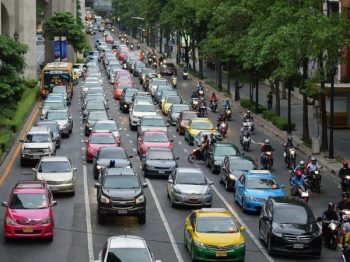
Rush hour - we’ve all heard of this phrase and perhaps we do every day. Indeed, it’s something that a lot of us avoid and that’s mostly so that we don’t end up late to work, school, or appointments.
Most of the times, it’s usually “Leave the house early so you don’t get stuck at rush hour,” or “Let’s leave for the mall after rush hour so we won’t be late.”
Indeed, rush hour is a hassle all over the world and it’s a day-to-day occurrence, especially during the weekdays. Here we outline how rush hour affects our lives.
A Common Problem

On an average, the rush hours all over the world are at 7am - 9am in the morning. This is usually the time where people drive going to work or school. Since most jobs and schools also open at this time, it’s no wonder that there are a lot of vehicles on the streets and roads. For the afternoon, it’s also usually at 3pm - 5pm, a common time work and school also end and where commuters rush to get home or to their after-work or after-school appointments. Traffic is now worse than it's ever been as the number of vehicles on streets at any time has drastically increased over the years.
Almost Everyone Has Cars
One of the biggest contributors to rush hour are personal vehicles. Imagine, there’s a single company with around 100 employees. Let’s say around 80% of those employees have their own vehicles. That’s bound to contribute to the traffic congestion. Let’s take LA for an example, in a 2017 study, it was found that 84% of commuters chose to drive going to work. Your vehicles are costing you more money than you think just sitting around in traffic. The average commuter wastes around 60 liters of fuel a year just sitting in traffic.
The Bigger the City, the Bigger the Congestion
Evidently, the bigger the city, the more businesses, schools, and companies there are. And that means more residents, more commuters, and more traffic congestion during rush hours. Congestion builds through the week from Monday through Friday. Traffic on Thursday is almost as bad as traffic on Friday! The bigger the city, the more traffic there is to get stuck in. In cities of over 1 million people, they spent an average of 71 hours stuck in traffic. These cities also experienced a road network that was congested for approximately 6 hours of the average weekday. According to the INRIX 2018 Global Traffic Scorecard, the top 10 most congested cities in the world are:
- Moscow, Russia – 210 hours lost in congestion
- Istanbul, Turkey – 157 hours
- Bogotá, Colombia – 272 hours
- Mexico City, Mexico – 218 hours
- São Paulo, Brazil – 154 hours
- London, United Kingdom – 227 hours
- Rio de Janeiro, Brazil – 199 hours
- Boston, MA, United States – 164 hours
- Saint Petersburg, Russia – 200 hours
- Rome, Italy – 254 hours
Not Just About Being Late
While we’re mostly concerned about punctuality when it comes to rush hour, there’s also another aspect where it creates a negative affect and that’s our health and the environment’s too. As more cars congest in the streets, the more we exposed we are to pollution from the exhausts that many vehicles emit. Bad driving behavior like driving and braking too fast can cause even more traffic buildup behind you. This is due to chain reactions.
The next time you get into rush hour, don’t just think about your appointment. Think about your respiratory health too! It is best to drive at a steady pace. Try to avoid rush hour by driving at other times, using apps like Waze to avoid traffic, and use public transport as much as you can. Vehicles and sitting in traffic is also very expensive. What are some of your opinions on rush hour?
